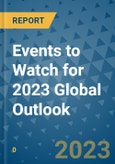In 2022, many executives across industries and geographies found their plans spoiled by a series of shocking macroeconomic and geopolitical events. The war in Ukraine, surging energy and food prices, and the fastest monetary tightening in decades all substantially altered the macroeconomic outlook and business environment.
In 2023, companies should expect this environment of uncertainty to continue, and prepare their business accordingly. The continuation of the war in Ukraine amplifies the risk of a direct war between Russia and NATO, as well as further disruptions to global food and energy supply. Persistent US-China tensions and the increasing insularity of China’s economy raise the probability of a confrontation over Taiwan. A rapid increase in interest rates may pave the way for further disruptive events, such as a global housing collapse, banking crisis, or commodity price crash.
While these events are far from guaranteed, the ability to anticipate, analyze, and prepare for them should be a top strategic priority.
Table of Contents
- Base-case Expectations for 2023
- Global Events to Watch for 2023
- China Invades Taiwan
- Global Housing Crash Drives a Severe Recession
- Russia and NATO Go to War
- Oil Prices Spike about US $130
- Food Supply Disruptions Drive Up Prices
- China's Property Market Collapses
- China Reopens Prematurely
- Commodity Prices Plummet
- The Fed Ends Rate Hikes Early
- Events to Watch Methodology
Methodology
The author’s strengths include global management topics and country level analysis tailored for a senior executive audience. The research focuses on cross-industry implications of macroeconomic, geopolitical risk, and emerging trends that impact the strategic decisions of business decisionmakers.
Research analysts:
Almost all have advanced degrees in economics, international affairs, or political science, and are multilingual. Researchers have lived and worked in the markets they cover and are based in regional hubs close to market
- Analysts cover:
- Economic trends and indicators (near-term volatility, long-term forecasts); political developments (election results, post-election policy, regulations, spending, monetary policy), outlook for market demand and cost of doing business, upside and downside scenarios, MNC investment sentiment, business practices
- Quality control:
- Research workflows supported by standard, proprietary process maps, tools and templates for analysis and writing, forecast admin tool, and content management system
- Research managers pressure-test quality, consistency and usefulness of outlooks, scenarios, and suggested actions
- Analyst interactions with clients (>1500/year) provide ongoing feedback loops from on-the-ground operators to c-suite
- Research inputs include:
- Primary: Multinational and local executives (interviews, surveys, analyst consultations), international and local experts (NGO officials, academics, consultants), international and local government officials
- Secondary: Local-language news and international media, public/official data sources, government/association reports, Bloomberg
- Research outputs include:
- Forecast economic data, country/region outlooks and scenarios, market intelligence reports (monthly/quarterly for key countries as well as occasional Market Spotlights), as-needed analyst commentary alerts

LOADING...








